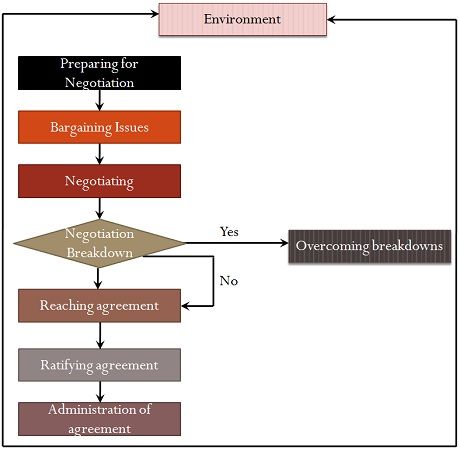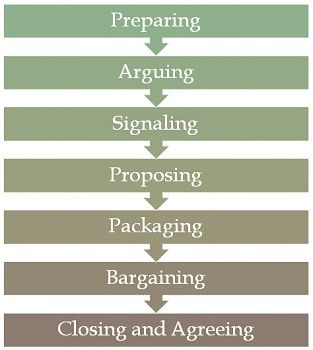 Collective Bargaining can be understood as a rulemaking process, as it formulates or revises the terms and conditions, under which the worker’s group and management, may cooperate and work together, over a certain period. It is not similar to negotiation, which implies a process of seeking agreement, through an open end exchange of views.
Collective Bargaining can be understood as a rulemaking process, as it formulates or revises the terms and conditions, under which the worker’s group and management, may cooperate and work together, over a certain period. It is not similar to negotiation, which implies a process of seeking agreement, through an open end exchange of views.
Industrial disputes are the disputes that occur out of a disagreement between employer and employees concerning certain issues relating to employment. Whenever there is a clash of interest, dissatisfaction may arise in either of the parties involved that results in protests, strikes, lockout, dismissal of workers and so forth. To avoid such situations, the parties can take recourse of dispute resolving techniques like collective bargaining or negotiation.
Take a read of this article, in which we have explained the differences between collective bargaining and negotiation.
Content: Collective Bargaining Vs Negotiation
Comparison Chart
| Basis for Comparison | Collective Bargaining | Negotiation |
|---|---|---|
| Meaning | Collective Bargaining refers to the process of discussion, in which the representative of employees and management, determine the employees wages and benefits. | Negotiation is a process in which two or more parties, discuss specific offers, with a view to reach a mutually acceptable agreement. |
| Nature | Competitive | Cooperative |
| Relationship | Win-lose relationship | Win-win relationship |
| Stresses on | Who is right? | What is right? |
Definition of Collective Bargaining
Collective Bargaining, as the name suggests, is a group action involving negotiation between the representative of employees and the management, on the matters relating to employment, so as to arrive at an agreement. The collective agreement is an understanding, on account of the terms and conditions under which the service is to be carried on.
The terms of employment encompass items like working conditions, workplace rules, working hours, salaries, compensation, retirement benefits, overtime pay, leaves with pay and so on.
The discussion takes place between union leader, who acts as the representative of the trade union and the representative of the employer. It incorporates the process of negotiation, administration and interpretation of the collective agreement. The functions of collective bargaining are:
- Formulating the rules of the workplace
- Ascertaining the form of compensation
- Standardizing compensation
- Determining priorities on each side
- Redesigning the machinery of bargaining.
Video: Collective Bargaining
Definition of Negotiation
Negotiation refers to a process which allows the people of different interest to arrive at a mutually acceptable agreement on an issue, but at the same time seeking to increase the benefit to be gained for their interest group. The basic objective of negotiation is to reconcile the differences between employer and employees and to suggest ways of fulfilling their expectations.
Negotiation is a common technique adopted by an ordinary human being, in the day to day life, such as, to negotiate for items like higher salary, solving a dispute with the coworker or settling business conflicts. There are four approaches to negotiation:
- Win-lose orientation: An approach adopted by competitive communicators, that relies on the premises that only one party reach the goal while the other one loses.
- Lose-lose orientation: In this approach, the conflict takes place in such a manner that both the parties suffer damages and feels like a loser.
- Compromise: When the parties agree to settle at best obtainable outcome, it is known as compromise. In this approach, the parties think it better to compromise rather than fighting the battle.
- Win-win orientation: Last but not the least is a win-win orientation, which is collaborative in nature and satisfies the requirements of all the parties involved.
Key Differences Between Collective Bargaining and Negotiation
The points given below are substantial so far as the difference between collective bargaining and negotiation is concerned:
- Collective Bargaining is a process through which the group of workers, haggle the contract with the employer to ascertain terms and conditions of employment, such as wages, working hours, health and safety. Conversely, negotiation is a process, in which people of different interest groups come together and reach a mutually acceptable outcome of a problem while maximising the benefit to be obtained for their interest group.
- Collective Bargaining is competitive in nature, in the sense that either of the parties involved attempts to make the other party agree to their terms. Conversely, negotiation is cooperative in nature, such that it seeks to find out the best obtainable outcome for both the parties.
- In collective bargaining, the relationship between two parties is a win-lose relationship, wherein one party wins, and the other one loses. Unlike negotiation, there exists a win-win relationship between parties concerned, wherein both the parties gain something from the discussion.
- While collective bargaining tries to prove who is right, negotiation is all about proving what is right.
Conclusion
By and large, the legislative process by which the employer and the employees agree to the terms and conditions of work is collective bargaining. On the other end, negotiation is a goal-oriented process that aims at reconciling the differences between the management and labour union, by devising the ways to resolve the differences.








Leave a Reply